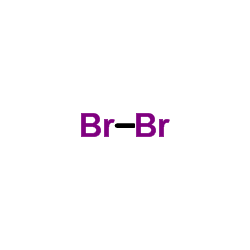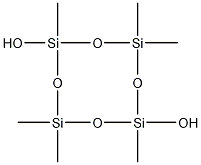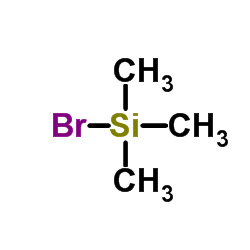7789-66-4
| 中文名 | 溴化硅(IV) |
|---|---|
| 英文名 | Silicon(IV) bromide |
| 中文别名 |
四溴化硅
溴化硅 |
| 英文别名 |
EINECS 232-182-4
MFCD00049530 tetrabromosilane |
| 密度 | 2.8 g/mL at 25 °C(lit.) |
|---|---|
| 沸点 | 153 °C(lit.) |
| 熔点 | 5 °C(lit.) |
| 分子式 | Br4Si |
| 分子量 | 347.70200 |
| 闪点 | 154°C |
| 精确质量 | 343.65000 |
| LogP | 3.00160 |
| 蒸汽密度 | 2.8 (vs air) |
| 折射率 | 1.5627 |
| 储存条件 | 干性的保护气体下处置, 保持贮藏器密封 放入紧密的贮藏器内,储存在阴凉,干燥的地方 |
| 稳定性 | 如果遵照规格使用和储存则不会分解 避免接触水分/潮湿。可与金属钾剧烈反应。 |
| 计算化学 | 1.疏水参数计算参考值(XlogP):无 2.氢键供体数量:0 3.氢键受体数量:0 4.可旋转化学键数量:0 5.互变异构体数量:无 6.拓扑分子极性表面积0 7.重原子数量:5 8.表面电荷:0 9.复杂度:19.1 10.同位素原子数量:0 11.确定原子立构中心数量:0 12.不确定原子立构中心数量:0 13.确定化学键立构中心数量:0 14.不确定化学键立构中心数量:0 15.共价键单元数量:1 |
| 更多 | 1. 性状:无色透明的液体,易水解,在空气中发烟。 2. 密度(g/mL 25ºC):2.814 3. 相对蒸汽密度(g/mL,空气=1):未确定 4. 熔点(ºC):5.2 5. 沸点(ºC,常压):152.8 6. 沸点(ºC,5.2kPa):未确定 7. 折射率(n20/D):未确定 8. 闪点(ºC,):未确定 9. 比旋光度(º):未确定 10. 自燃点或引燃温度(ºC):未确定 11. 蒸气压(kPa,25ºC):未确定 12. 饱和蒸气压(kPa,60ºC):未确定 13. 燃烧热(KJ/mol):未确定 14. 临界温度(ºC):未确定 15. 临界压力(KPa):未确定 16. 油水(辛醇/水)分配系数的对数值(25℃):未确定 17. 爆炸上限(%,V/V):未确定 18. 爆炸下限(%,V/V):未确定 19. 溶解性(mg/mL):未确定 |
|
Section 1: Product Identification Chemical Name:Silicon (IV) bromide, 99+% CAS Registry Number:7789-66-4 Formula:SiBr4 EINECS Number:232-182-4 Chemical Family:metal halide Synonym:Silicon tetrabromide
Section 2: Composition and Information on Ingredients IngredientCAS NumberPercentACGIH (TWA)OSHA (PEL) Title Compound7789-66-4100%no datano data Section 3: Hazards Identification Extremely destructive to tissue of the respiratory tract, eyes and skin. Material hydrolyzes in contact with Emergency Overview: moisture releasing corrosive hydrogen bromide fumes. Primary Routes of Exposure:Ingestion, inhalation, skin, eyes Eye Contact:Liquid and vapors will cause burns to the eyes and blindness. Skin Contact:Corrosive to skin. Contact can lead to redness, pain, blistering, ulceration, and scar formation. Inhalation of choking fumes will result in burns to the respiratory tract, chemical pneumonitis and pulmonary Inhalation: edema. Ingestion:Ingestion is unlikely due to pungent choking odor. Causes burns to the gastrointestinal system. May be harmful if swallowed, inhaled or absorbed through the skin. Material is extremely destructive to tissue Acute Health Affects: of the mucous membranes and upper respiratory tract, eyes and skin. Chronic Health Affects:No information available on long-term chronic effects. NTP:No IARC:No OSHA:No SECTION 4: First Aid Measures Immediately flush the eyes with copious amounts of water for at least 10-15 minutes. A victim may need Eye Exposure: assistance in keeping their eye lids open. Get immediate medical attention. Wash the affected area with water. Remove contaminated clothes if necessary. Seek medical assistance if Skin Exposure: irritation persists. Remove the victim to fresh air. Closely monitor the victim for signs of respiratory problems, such as difficulty Inhalation: in breathing, coughing, wheezing, or pain. In such cases seek immediate medical assistance. Seek medical attention immediately. Keep the victim calm. Give the victim water (only if conscious). Induce Ingestion: vomiting only if directed by medical personnel. SECTION 5: Fire Fighting Measures Flash Point:not applicable Autoignition Temperature:none Explosion Limits:none Extinguishing Medium:none required If involved in a fire, fire fighters should be equipped with a NIOSH approved positive pressure self-contained Special Fire Fighting Procedures: breathing apparatus and full protective clothing. Hazardous Combustion andIf involved in a fire this material may emit corrosive hydrogen bromide fumes. Decomposion Products: Unusual Fire or Explosion Hazards: No unusual fire or explosion hazards. SECTION 6: Accidental Release Measures Small spills can be mixed with powdered sodium bicarbonate, lime, or calcium carbonate and swept up. Spill and Leak Procedures:Spillage in areas not adequately ventilated may require an evacuation of area. Emergency response teams will require self-contained breathing apparatus. SECTION 7: Handling and Storage Store material in a tightly sealed bottle away from moisture. If possible, handle material in an efficient fume Handling and Storage: hood. Exposure to the atmosphere may lead to degradation of the product. SECTION 8: Exposure Controls and Personal Protection Eye Protection:Always wear approved safety glasses when handling a chemical substance in the laboratory. Skin Protection:Wear protective clothing and gloves. Consult with glove manufacturer to determinew proper type of glove. Ventilation:If possible, handle the material in an efficient fume hood. In the absence of adequate ventilation a respirator should be worn. The use of a respiratory requires a Respirator: Respirator Protection Program to be in compliance with 29 CFR 1910.134. Ventilation:If possible, handle the material in an efficient fume hood. Additional Protection:Protective work clothing. SECTION 9: Physical and Chemical Properties Color and Form:colorless liq. Molecular Weight:347.72 Melting Point:5.4° Boiling Point:154°C Vapor Pressure:no data Specific Gravity:2.772 Odor:Pungent odor. Solubility in Water:reacts with water SECTION 10: Stability and Reactivity Stability:moisture sensitive Hazardous Polymerization:no hazardous polymerization Conditions to Avoid:contact with moisture Incompatibility:Water, alcohols, strong bases, and active metals. Decomposition Products:with moisture: hydrogen bromide and hydrobromic acid. SECTION 11: Toxicological Information RTECS Data:No information available in the RTECS files. Carcinogenic Effects:no data Mutagenic Effects:no data Tetratogenic Effects:no data SECTION 12: Ecological Information Ecological Information:No information available SECTION 13: Disposal Considerations Disposal:Dispose of according to local, state and federal regulations. SECTION 14: Transportation Shipping Name (CFR):Corrosive liquids, N.O.S. Hazard Class (CFR):8 Additional Hazard Class (CFR):NA Packaging Group (CFR):II UN ID Number (CFR):UN# 1760 Shipping Name (IATA):Corrosive liquid, N.O.S. Hazard Class (IATA):8 Additional Hazard Class (IATA):NA Packaging Group (IATA):II UN ID Number (IATA):UN# 1760 SECTION 15: Regulatory Information TSCA:Listed in the TSCA inventory. SARA (Title 313):Title compound not listed. Second Ingredient:none SECTION 16 - ADDITIONAL INFORMATION N/A |
|
生态学数据: 对水是稍微危害的,若无政府许可,勿将材料排入周围环境
|
| 符号 |

GHS05 |
|---|---|
| 信号词 | Danger |
| 危害声明 | H314 |
| 警示性声明 | P280-P305 + P351 + P338-P310 |
| 个人防护装备 | Faceshields;full-face respirator (US);Gloves;Goggles;multi-purpose combination respirator cartridge (US);type ABEK (EN14387) respirator filter |
| 危害码 (欧洲) | C: Corrosive; |
| 风险声明 (欧洲) | R34 |
| 安全声明 (欧洲) | S26-S27-S28-S36/37/39 |
| 危险品运输编码 | UN 3264 8/PG 2 |
| WGK德国 | 3 |
| 包装等级 | II |
| 危险类别 | 8 |
| 上游产品 9 | |
|---|---|
| 下游产品 10 | |



















